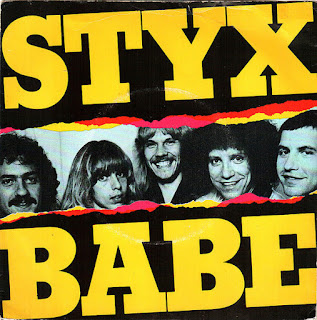STYX - LADY / BABE
LADY
Released: September 1973
Charted: US: #6
"Lady" is a power ballad written and performed by the rock band Styx in 1973. Initially released on “Styx II”, it became a local hit in Chicago but failed to chart nationally. After Styx moved to A&M Records in 1974, the song gained nationwide airplay, eventually reaching #6 on the Billboard Hot 100 in March 1975. Due to a contractual dispute between A&M and Wooden Nickel Records, "Lady" was re-recorded for the 1995 Styx compilation “Greatest Hits”.
Dennis DeYoung, the keyboard player of Styx, penned "Lady" as a tribute to his wife Suzanne, whom he met in high school and considered a paragon of grace and elegance. He continued to immortalize their relationship in other songs like "Babe" and "The Best Of Times." Despite facing health challenges in the late '90s that led to his departure from the band, DeYoung's marriage to Suzanne remained steadfast.
Dennis DeYoung crafted "Lady" in 1972, but Styx's record label initially rejected it for their debut album that same year. It found a home on their second album, "Styx II," released in 1973, and was issued as a single. Despite its early struggles, the song's fortunes changed thanks to the persistent efforts of a DJ at WLS in Chicago, the band's hometown. Determined to propel it to success, the DJ showcased the song nightly at 8 p.m. until it gained traction. Eventually, other stations followed suit, leading to its widespread acceptance and airplay. DeYoung's reaction upon hearing it on the radio for the first time was one of sheer excitement, even causing him to choke on his dinner.
"Lady" marked a significant milestone for Dennis DeYoung as it was the first song he wrote and sang on his own that made it onto a record. Notably, the debut Styx album had just two songs penned by band members. "Lady" heralded a shift as the band members began writing their own original material, with DeYoung emerging as a primary songwriter from that point forward.
BABE
Released: September 14, 1979
Charted: US: #1 (2 weeks) UK: #6
"Babe" by the American rock band Styx served as the lead single from their 1979 triple-platinum album "Cornerstone." Notably, it marked Styx's first and only US number-one single, reigning for two weeks in December 1979, making it a significant close to the 1970s music era. Additionally, the song soared to No. 9 on the Adult Contemporary chart. Its success extended beyond the US, holding the number-one spot for six weeks on the Canadian RPM national singles chart and became the opening chart-topper of the 1980s. In the UK, "Babe" was the band's only Top 40 hit, peaking at No. 6, and it also clinched the No. 1 spot in South Africa.
"Babe" holds a heartfelt origin as Dennis DeYoung penned it as a birthday gift for his wife, Suzanne. Initially conceived as a personal gesture rather than a Styx track, DeYoung's record company recognized its potential and insisted it be included on the album. DeYoung's original demo, featuring bassist Chuck Panozzo and drummer John Panozzo, resonated so well that it became the album version, with only a Tommy Shaw guitar solo added. DeYoung's vocals, including harmonies, were all self-recorded, adding to the intimate nature of the song.
Dennis DeYoung's touch was unmistakable on "Babe" as he not only provided the lead vocals but also showcased his keyboard prowess, particularly on the opening segment where he employed the soothing tones of a Fender Rhodes electric piano, a hallmark instrument of the '70s era.
According to Cash Box, "Babe" boasts "crystalline singing and airy electric piano leads," with particular praise for its "high harmonies." Billboard described it as a "melodic pop number" with potential for success on adult contemporary playlists. Record World lauded its "playful keyboards," "youthful lead vocal," "full harmony chorus," and "ascending lead guitar runs." Eric Hegedus of The Morning Call praised it as a prime example of Styx's adeptness at slow love songs, emphasizing the "deceptively simple lyrics."



































